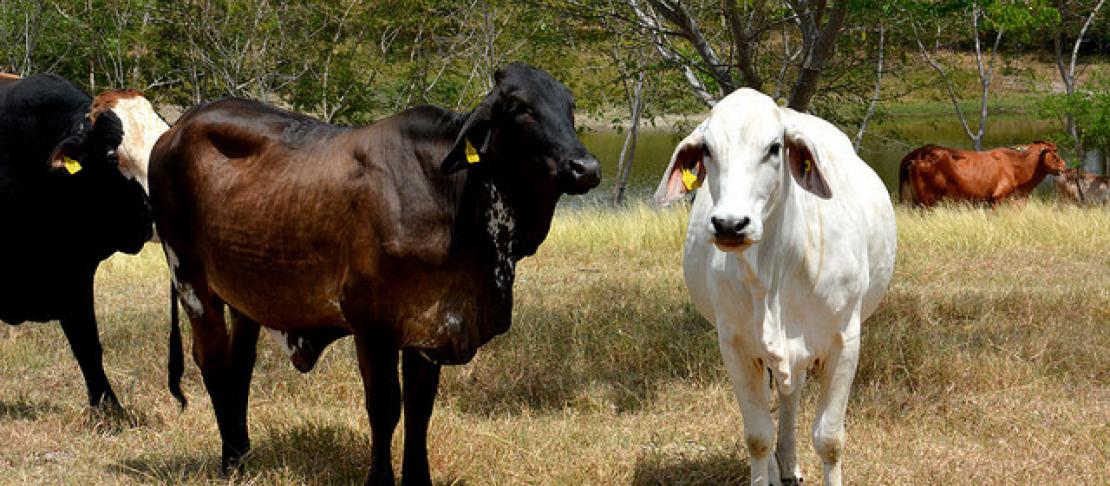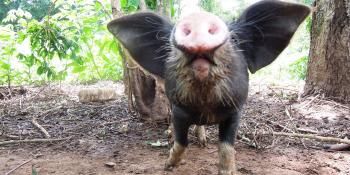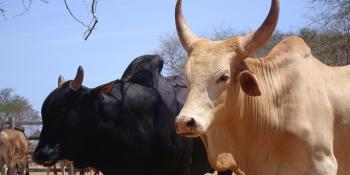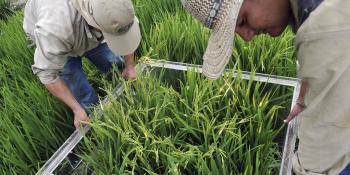Catalyzing farmer innovations and the adoption of promising management and technological options to facilitate the development of low-carbon cattle value chains in Latin America

Project description
Latin America has the potential to be at the forefront of transformation in livestock sector towards more productive and sustainable cattle value chains (VC) through cattle breeds fed on high-quality forages and kept in good health. This production alternative will result in higher market value due to the high appreciation of products developed with low emissions. Low-emitting technologies and management practices for reducing greenhouse gas (GHG) emissions to maximize cattle productivity and cattle VC performance are commonly known, as could be identified by previous projects like LivestockPlus. However, it’s necessary to proactively adopt better known, profitable, and best-fit mitigation options. That’s why this project is working hand in hand with the Latin America Mitigation Network (LAMNET) to bring multi-disciplinary livestock and non-livestock stakeholders together and strengthen South-South collaboration among VC actors in target countries: Colombia, Guatemala, Honduras, El Salvador, Peru, and Nicaragua. Working with LAMNET, our goal is to foster creative low-emissions business models, feasible monitoring, reporting, and verification (MRV) approaches public-private partnerships and alliances, and the development of mechanisms (i.e., finance schemes) that incentivize the accelerated and sustainable implementation of promising innovations and best-fit practices by VC actors. However, to get to know the decision criteria in the adoption of practices to increase cattle productivity while reducing GHG emissions, we are researching life cycle analysis (LCA); food loss and waste reduction and utilization as alternative cattle feed options; and human behavioral science.
Activities
- Improving cattle value chain performance and meeting emission reduction targets
- Evaluating climate change mitigation options, building regional capacities and the effective communication of research findings
Expected outcomes
- At least five agricultural Nationally Appropriate Mitigation Actions (NAMA)/climate finance proposals.
- Guidance on more efficient management options with mitigation co-benefits
- Stakeholders use improved emissions data and tools.
- 6–8 countries trained in scenarios analysis for low emissions development (LED) planning and MRV methodologies.
- Revised targets and NDCs for agricultural mitigation.
- Methods for MRV of agricultural emission reductions developed.
- Improved capacity of the United Nations Framework Convention on Climate Change (UNFCC), NAMA and LED focal points & policy implementers to measure and monitor mitigation.
- NAMA or LED investment proposals for 6–8 countries include gender considerations
- Ten countries have used tools, analysis, business models and MRV methodologies to develop LED plans with mitigation potential.
- Analysis of lessons learned from trials for best practices to support scaling up of LED options in agri-food sectors.
Gender and youth
This project ensures that gender, youth and indigenous community issues are included in all discussion platforms by inviting stakeholders from the relevant ministries in each of the target countries. The project also explores opportunities to build the income generation capacities of these groups in each target country.
More information
- LivestockPlus project page: Supporting low emissions development in the Latin American cattle sector (LivestockPlus)
For further information, please contact project leader, Jacobo Arango (CIAT) (j.arango@cgiar.org).
Project Deliverables
Article for media/Magazine/Other (not peer-reviewed)
Very high nitrous oxide fluxes from rice cannot be generalized for water management and climate impacts
Book
The business of a productive, resilient and low emission future
Journal Article (peer reviewed)
Improved soil water management to improve crop yield and sequester carbon
Multimedia
Media Interview: Management of fertilizers in livestock farming
Conference paper / Seminar paper
Productive and environmental performance of forage-based silvopastoral systems
Multimedia
Media Interview: Mitigation of greenhouse gases in livestock systems
Journal Article (peer reviewed)
Paper on the effect of pasture degradation on N2O emissions from the soil
Policy brief/policy note/briefing paper
Info Note Youth in livestock: strategic partnerships with a private company
Conference paper / Seminar paper
Methane emissions of cattle fed with forages of contrasting nutritional value
Social Media Output
Capacity building of women and youth farmers along the livestock supply chain
Journal Article (peer reviewed)
Effects of long-term mixed diet supplementation in rumen dynamics and CH4 emissions
Conference paper / Seminar paper
Measurements of gross nitrification improve our understanding of biological nitrification inhibition (BNI)
Book chapter
2019 Refinement to the 2006 IPCC Guidelines for National Greenhouse Gas Inventories -chapter 2
Journal Article (peer reviewed)
Paper on effect of plant chemical composition on rumen dynamics in crossfed heifers
Journal Article (peer reviewed)
The role of tropical forages in improving soil health in livestock systems
Book chapter
2019 Refinement to the 2006 IPCC Guidelines for National Greenhouse Gas Inventories -chapter 5
Journal Article (peer reviewed)
Management strategies to improve nutrient acquisition and reduce GHG emissions in tropical pastures
Book chapter
2019 Refinement to the 2006 IPCC Guidelines for National Greenhouse Gas Inventories -chapter 6
Journal Article (peer reviewed)
How to measure, report and verify soil carbon change to realise the potential of soil carbon sequestration for atmospheric greenhouse gas removal
Journal Article (peer reviewed)
Priorities for low-carbon VC development defined with actors and strategies planned,
Article for media/Magazine/Other (not peer-reviewed)
Raising awareness amongst key stakeholders on the business and investment unusual approach being taken by the project
Book chapter
2019 Refinement to the 2006 IPCC Guidelines for National Greenhouse Gas Inventories -chapter 11
Discussion paper/Working paper/White paper
Mitigation actions through silvopastoral systems in LAC
Policy brief/policy note/briefing paper
Evolution of Public Policies Related to the Cattle and Dairy Sector in Colombia: Tension between tradition and modernity
Journal Article (peer reviewed)
CGIAR operations under the plant treaty framework.
Journal Article (peer reviewed)
Business and market opportunities for sustainable livestock products
Journal Article (peer reviewed)
Potential of mitigation of GHG emissions through the adoption of improved forages
Journal Article (peer reviewed)
Pasture diversification affects soil macrofauna and soil biophysical properties in tropical (silvo)pastoral systems
Journal Article (peer reviewed)
Variation in plant root exudates affect the BNI capacity of Brachiaria grasses and N cycling in tropical grasslands
Journal Article (peer reviewed)
Phenotyping of a germplasm collection of Guineagrass for capacity of BNI and reduction of nitrous oxide emissions
Newsletter
The scaling challenge and how to overcome it
Funder report
Products for effective and transformational communication on mitigation opportunities in the livestock sector in LAC
Journal Article (peer reviewed)
Effect of the addition of tree legume pods to Brachiaria brizantha on dry matter degradation, volatile fatty acid concentration and methane production in vitro
Journal Article (peer reviewed)
Towards low carbon agriculture: Systematic-narratives of climate-smart agriculture mitigation potential in Africa
Journal Article (peer reviewed)
Improved nutrient cycling in mixed grass-legume pastures in the Amazon of Colombia allow higher forage yield, N and P uptake
Journal Article (peer reviewed)
Effect of dried leaves of Leucaena leucocephala on cattle rumen fermentation, rumen microbial population, and enteric methane production in crossbred heifers
Journal Article (peer reviewed)
Effect of Urochloa grasses on microbial nitrogen cycling in soil towards N2O mitigation
Journal Article (peer reviewed)
Validation of a high-throughput method for real time measurement of greenhouse gases (enteric methane)
Journal Article (peer reviewed)
Development of a NIRS-based method for estimating nutritional quality parameters key to reduce emission intensities
Journal Article (peer reviewed)
Role of Secondary Plant Metabolites on Enteric Methane Mitigation in Ruminants
Discussion paper/Working paper/White paper
InfoNote: Educate and empower: “Heirs of tradition” as agents of change.
Journal Article (peer reviewed)
Review: Strategies for enteric methane mitigation in cattle fed tropical forages
Journal Article (peer reviewed)
Technological, management and institutional innovations that support sustainable and inclusive VCs.
Policy brief/policy note/briefing paper
Greening of livestock landscaped under climate change 2DI initiative
Journal Article (peer reviewed)
Carbon Storage Potential of Silvopastoral Systems of Colombia
Journal Article (peer reviewed)
Ambition meets reality: achieving GHG emission reduction targets in the livestock sector of Latin America
Partners
- Agropecuaria Bambusa SAS
- Alliance of Bioversity and CIAT - Regional Hub (Centro Internacional de Agricultura Tropical) (CIAT (Alliance))
- Alqueria
- Centro para la Investigacion en sistemas sostenibles de produccion agropecuaria (CIPAV)
- Global Research Alliance on Agricultural Greenhouse Gases
- Ministerio de Agricultura y Desarrollo Rural (Colombia) (MADR)
- Ministerio de Agricultura y Ganadería (Costa Rica) (MAG)
- Ministerio de Agricultura y Riego (Peru) (MINAGRI)
- Ministerio de Agricultura, Ganadería y Alimentación (Guatemala) (MAGA)
- Secretaría de Agricultura y Ganadería (Honduras) (SAG)
- Universidad Autónoma de Yucatán (UADY )
- Universidad Nacional de Colombia (UNAL)


